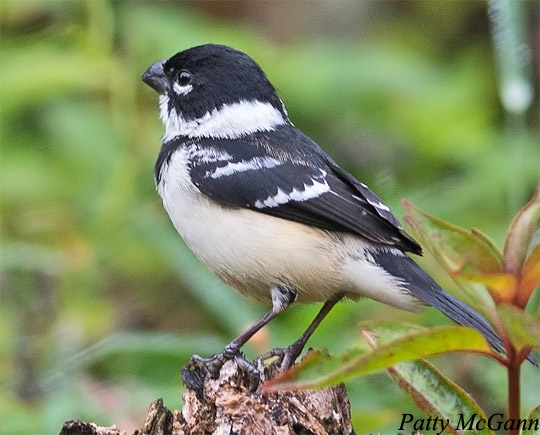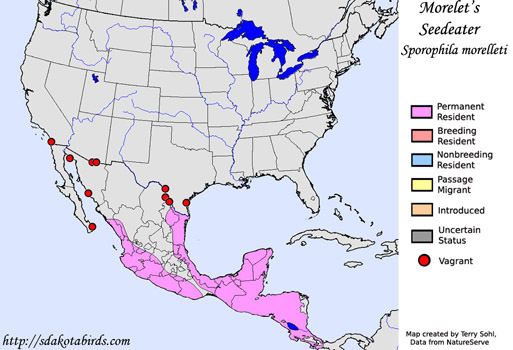| Length: 4.25 inches | Wingspan: 8 inches | Seasonality: Non-resident in South Dakota |
| ID Keys: Very stout, thick bill, white collar, black head, white underneath, black upperparts | ||
 The
Morelet's Seedeater is a very small bird of Mexico and Central America,
with a range that just reaches the United States in extreme southern Texas
near the Rio Grande river. In Texas, it was once more common than it is
today. In the early 20th century, they were relatively common in far
southern Texas, but by 1970 they were nearly absent. Small numbers are
now again occasionally found in Texas, where they are confirmed as breeders
again. The species has also been seen on very rare occasions in
extreme southern Arizona and California.
The
Morelet's Seedeater is a very small bird of Mexico and Central America,
with a range that just reaches the United States in extreme southern Texas
near the Rio Grande river. In Texas, it was once more common than it is
today. In the early 20th century, they were relatively common in far
southern Texas, but by 1970 they were nearly absent. Small numbers are
now again occasionally found in Texas, where they are confirmed as breeders
again. The species has also been seen on very rare occasions in
extreme southern Arizona and California.
Habitat: Found in a variety of open habitats including grasslands, roadsides, pastures, marshland, savannas, and forest clearings and edges. They are often found near sources of water, such as in riparian areas.
Diet: Feeds heavily on seeds, particularly grass seeds. They will also take insects and spiders. They may also sometimes take berries and small fruits.
Behavior: Gregarious outside of the breeding season, they are often found foraging in small flocks. Foraging is done low in vegetation or on the ground, where they may move through grassy areas, plucking seeds from grass and weed stems.
Nesting: The nest is a cup placed low to the ground, constructed of twigs, spider webs, grasses, weed stems, plant down, and other vegetative material. The female lays between 2 and 4 eggs, and she alone incubates them. The young hatch after almost 2 weeks, and both parents help to feed and raise the young. They often nest multiple times, raising up to 3 broods in a single season.
Song: The song is a musical series of two pitches, weet-weet-weet-cheer-cheer-cheer.
Migration: Considered a permanent resident throughout its range. Small foraging flocks may move short distances outside of the breeding season in search of optimal foraging areas.
Feeders: Will readily attend feeders for millet and standard feeder seed mixtures.
Interactive eBird map: Click here to access an interactive eBird map of Morelet's Seedeater sightings
Similar Species: Distinctive if seen well, with unique plumage pattern. The powerful, stout bill is also a good identification mark.
Conservation Status: Populations of Morelet's Seedeater appear to be increasing, they cover a wide geographic region, and they are common in many parts of their range. The IUCN lists the Morelet's Seedeater as a species of "Least Concern".
Further Information: 1) WhatBird - Morelet's Seedeater
2) Audubon Guide - Morelet's Seedeater
3) Cornell's NeoTropical Birds - Morelet's Seedeater
Photo Information: Photo by Patty McGann - March 14th, 2014 - Belize - Photo licensed under Creative Commons Attribution NonCommercial 2.0 Generic License
| Click below for a higher-resolution map |
 |
| South Dakota Status: Non-resident in South Dakota |
Additional Morelet's Seedeater Photos (coming soon!!)
